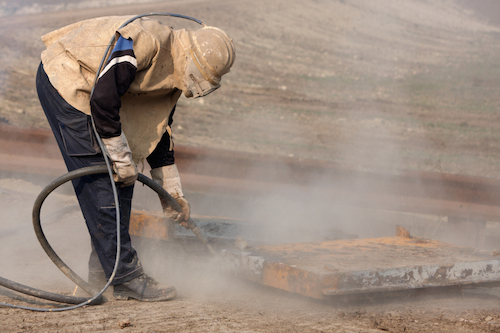Two abrasive-blasting standards and one related to coating film thickness have been updated by SSPC: the Society for Protective Coatings.
The three revised standards are:
SSPC-AB 1, Mineral and Slag Abrasives;
SSPC-AB 2, Cleanliness of Recycled Ferrous Metallic Abrasives; and
SSPC-PA 2, Procedure for Determining Conformance to Dry Coating Thickness Requirements.
SSPC-AB 1
SSPC-AB 1 contains requirements for:
Initial manufacturer qualification and classification of mineral and slag abrasive media;
Conformance inspection upon receipt by the purchaser; and
Quality control testing performed in the field by the contractor to verify that the media is free of contamination before use.
SSPC-AB 1SSPC-AB 1 contains requirements for:- Initial manufacturer qualification and classification of mineral and slag abrasive media;
- Conformance inspection upon receipt by the purchaser; and
- Quality control testing performed in the field by the contractor to verify that the media is free of contamination before use.

SSPC has made revisions to its SSPC-AB 1, SSPC-AB 2 and SSPC-PA 2 standards.
The intended audience for AB 1 includes abrasives manufacturers, specifiers, inspectors, contractors and testing laboratories.
The revised AB 1 contains two modifications:
The referenced test method for determining crystalline silica content has been changed from NIOSH Test Method 7603, "Quartz in coal mine dust, by IR (redeposition)," to NIOSH Test Method 7500, "Silica, Crystalline, by XRD."
The requirements for testing facilities, listed in Section 6.2 of the standard, have been simplified. Testing laboratories are no longer required to have ISO 17025 accreditation from an accreditation body that is a member of ILAC (International Laboratory Accreditation Cooperation) or NACLA (National Cooperation for Laboratory Accreditation). Shops performing the profile test are no longer required to be SSPC-QP 3 certified.
SSPC-AB 2
SSPC-AB 2 provides requirements for the cleanliness of recycled ferrous metallic blast cleaning abrasives used to remove coatings, paints, scale, rust and other foreign matter from steel or other surfaces.
The standard is intended to address the need to ensure that a work mix containing recycled ferrous metallic abrasive does not contain material that could compromise the performance of subsequently applied coatings.
Specifiers requiring the use of ferrous metallic abrasive media can specify AB 2 to keep the work mix free of oil and high levels of soluble salts, and to ensure recycled media shipped from a lead removal project is not a hazard to workers on an otherwise lead-free job.
AB 2 is relevant to SSPC courses C7, Abrasive Blasting Program; C1, Fundamental of Protective Coatings; and C2, Planning and Specifying Industrial Coatings Projects.
The standard's requirements for maximum lead content, freedom from oil, and maximum conductivity level remain the same as the 1996 version. However, the test frequency for each of these tests has been clarified:
Oil and conductivity testing are required once every 12 hours or work shift, whichever is shorter; and
The frequency of lab testing for lead content has been reduced from once per week to once immediately before first use.
Other revisions include:
A requirement has been added that the work mix shall be capable of producing the specified profile range as required by SSPC-PA 17, which requires periodic measurement of the cleaned surface for conformance to specified profile range. According to SSPC, this requirement provides a more practical field method to verify that excessive fines do not accumulate in the work mix and that the mix particle size remains consistent.
A nonmandatory note has been added to allow the specifier to invoke optional specification language to require preparation of a field standard for verification of work mix cleanliness (via ISO tape test) and profile (via PA 17).
A nonmandatory note has been added for optional specification language to require a weight test to determine the amount of non-abrasive residue in the work mix. The simplified test to determine the percentage of non-abrasive residue in the work mix by weight has been added to the nonmandatory appendix.

SSPC-PA 2
SSPC-PA 2 describes requirements for the number of dry coating thickness measurements needed to determine if an applied coating complies with the specified dry coating thickness range.
Relevant stakeholders for this standard include facility owners/specifiers, contractors, coating and lining inspectors and equipment manufacturers.
Significant revisions to PA 2 include:
Section 1.4 of the 2012 version has been removed. Nonmandatory Appendix 9 explains that the number of measurements taken during a coating failure investigation is not governed by the requirements of PA 2.
A definition of "certified standards" has been added.
Section 5.1 has been revised to require use of certified standards to verify that the gage is reading accurately before use, reflecting a revision in ASTM D7091. The use of measured shims is permitted when adjusting the gage for surface roughness or other characteristics.
Section 5.6 has been revised to state that Type I gages that do not read accurately cannot be used unless repaired and recalibrated by the manufacturer.
Section 6.1 has been revised to state that certified shims of non-magnetic metals or plastic shall not be used to verify the accuracy of Type I unless expressly approved by the gage manufacturer.
Section 10 requires the user to record only spot and area measurements, not individual gage readings. This reflects revisions made to ASTM D7091, which requires the user to record individual gage readings and was considered an unnecessary burden on users of PA 2.
Nonmandatory Appendix 1 now includes a figure to illustrate the procedure used to determine the extent of an area having a nonconforming DFT.
Nonmandatory Appendix A7, Section A7.1, now includes an example of coating thickness measurement frequency for carts/racks of pipe.
In Nonmandatory Appendix A7, Sections A7.2.1-A7.2.5, the term "Pipe Frequency DFT Level" has been changed to "Frequency Factor."
More information: www.sspc.org.